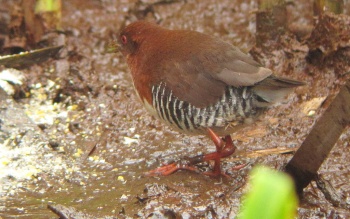- Rufirallus leucopyrrhus
Laterallus leucopyrrhus'
Identification
14–16cm (5½-6¼ in)
- Chestnut head, nape and upper back
- White underparts
- Black and white barred flanks
Sexes similar
Distribution
South America: found in marshes of south-eastern Brazil to Uruguay, Paraguay and northern Argentina.
Taxonomy
This is a monotypic species[1].
Habitat
Lowland marshes in dense tussocky areas.
Behaviour
Diet
Not well recorded. They appear to eat arthropods and insects, which they forage for on the ground in leaf litter.
Breeding
They are a monogamous species. They adults construct a round nest from grass; it has a side entrance.
References
- Clements, J. F., P. C. Rasmussen, T. S. Schulenberg, M. J. Iliff, T. A. Fredericks, J. A. Gerbracht, D. Lepage, A. Spencer, S. M. Billerman, B. L. Sullivan, M. Smith, and C. L. Wood. 2024. The eBird/Clements checklist of Birds of the World: v2024. Downloaded from https://www.birds.cornell.edu/clementschecklist/download/
- Handbook of the Birds of the World Alive (retrieved October 2018)
Recommended Citation
- BirdForum Opus contributors. (2025) Red-and-white Crake. In: BirdForum, the forum for wild birds and birding. Retrieved 18 May 2025 from https://www.birdforum.net/opus/Red-and-white_Crake
External Links
GSearch checked for 2020 platform.1





